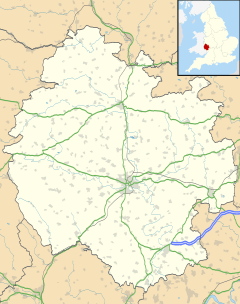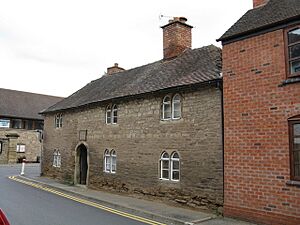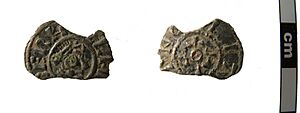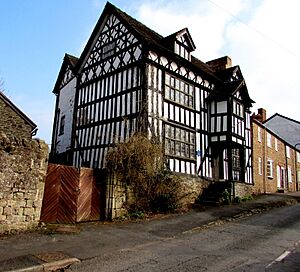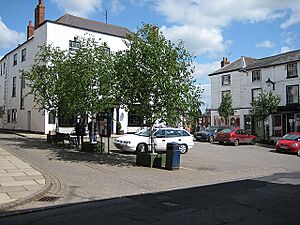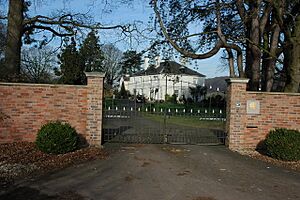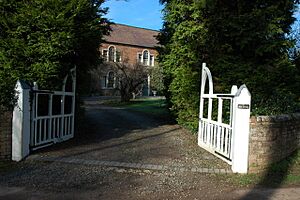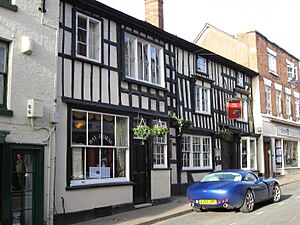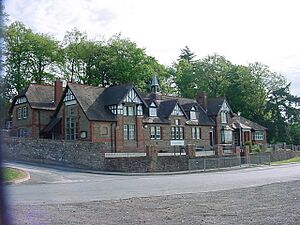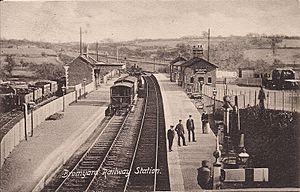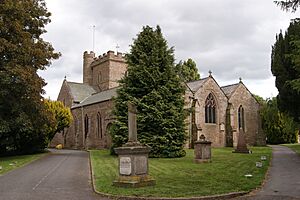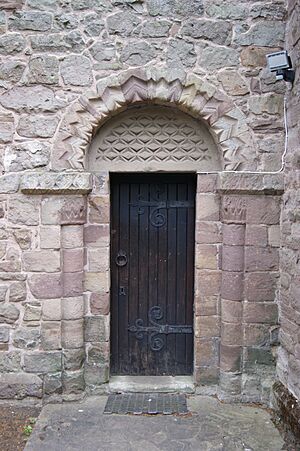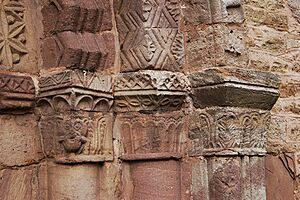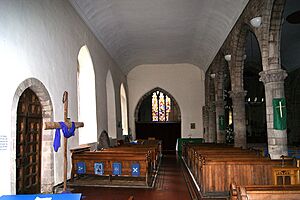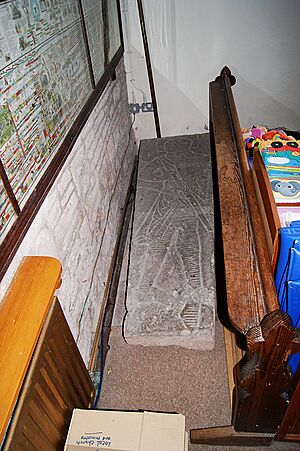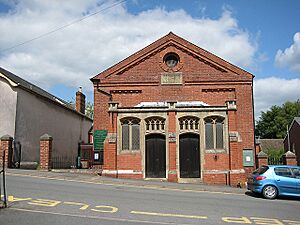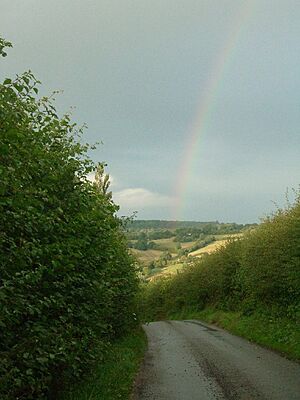Bromyard facts for kids
Quick facts for kids Bromyard |
|
|---|---|
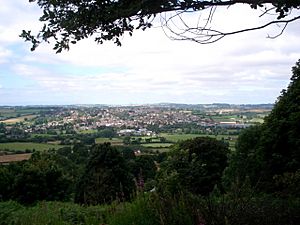 View of Bromyard from Bromyard Downs |
|
| Population | 4,500 |
| OS grid reference | SO654548 |
| Civil parish |
|
| Unitary authority | |
| Ceremonial county | |
| Region | |
| Country | England |
| Sovereign state | United Kingdom |
| Post town | BROMYARD |
| Postcode district | HR7 |
| Dialling code | 01885 |
| Police | West Mercia |
| Fire | Hereford and Worcester |
| Ambulance | West Midlands |
| EU Parliament | West Midlands |
| UK Parliament |
|
Bromyard is a historic town located in Herefordshire, England. It sits in the beautiful valley of the River Frome. The town is close to the border with Worcestershire and is found along the A44 road, which connects Leominster and Worcester. Bromyard is famous for its many old buildings with half-timbered walls, including some of its pubs. The local church is very old, dating back to the Norman times. For hundreds of years, Bromyard was a busy place with a market where farmers sold their animals.
Contents
Exploring Bromyard's Past
Bromyard has a long history, first mentioned around 840 AD. A bishop named Cuthwulf started a monasterium (a type of religious community) here. King Behrtwulf of Mercia gave permission for this. A local leader, Ealdorman Aelfstan, also received land near the River Frome.
In 1086, the Domesday Book, a famous survey of England, recorded Bromyard. It was one of the largest communities in Herefordshire. The town had 42 villani (villagers who worked the land), 9 bordars (small landowners), and 8 slaves. The name "Bromyard" first appeared in official records in 1291.
How Bromyard Became a Market Town
Bromyard likely became a market town around 1125. This was during the time of Bishop Richard de Capella. Like other towns such as Leominster and Ledbury, the bishops of Hereford had a large estate and a main church (minster) in Bromyard since Anglo-Saxon times. The church was special because it had many clergy members, but no single leader.
Old records from the 1280s show that Bromyard had 255 properties. These paid rent to the bishop. There was even a "Toll Shop" called Schallenge House. Here, people paid fees for selling goods at the market, and small legal problems were solved quickly.
After the Reformation in 1545, Bromyard was a very busy town. It had about 1200 people, making it the third-largest town in the county. However, by 1664, its population had fallen behind other nearby towns. The large parish of Bromyard included three smaller areas: Winslow, Linton, and Norton. These later became separate civil parishes.
Bromyard During the Civil War
During the English Civil Wars in the 1640s, Bromyard saw some conflict. In March 1645, troops led by Prince Rupert raided the area. They took everything from homes and farms, even killing young lambs. King Charles I himself stayed a night in Bromyard on September 3, 1645, at Mrs Baynham's house (now Tower House).
Schools and Education in Bromyard
Bromyard Grammar School was restarted in 1566. This happened after its original funding was taken by the government. In 1656, a man named John Perrin left money for the school. The school building is still in Church Street today. In 1969, it became part of the first comprehensive school in Herefordshire, now called Queen Elizabeth High School, Bromyard.
Bromyard as a Trading Hub
For many centuries, Monday was market day in Bromyard. The town was a key place for farming. Farmers sold local produce like beef, hops, apples, pears, and other soft fruits. Some farms were even owned by the church until recently. Local traders brought goods to the town's many shops, pubs, and inns.
In 1751, Bromyard got a Turnpike Trust. This meant a toll road was built to collect money for road repairs. By 1830, Bromyard's importance had lessened. This was partly because the Industrial Revolution arrived late to the town. It took a long time to connect Bromyard to the railway system. A stone quarry opened nearby in the 1870s, but it mostly made bricks and tiles until the 1970s.
Improving Town Life
Bromyard's water supply and sewage system were very poor until the late 1800s. In 1850, an inspector named Benjamin Herschel Babbage visited. He was shocked by the unhealthy conditions. He reported that many people did not want to pay for improvements. It took over 20 years for the town to act. Bromyard finally got a piped water supply in 1900.
During World War I, Bromyard had an internment camp. An Irish nationalist named Terence MacSwiney was held there. In World War II, Westminster School moved to buildings near Bromyard from 1940 to 1945.
From the 1950s to 1960s, Bromyard grew with new homes and shops. A bypass road was built in the 1970s. This helped traffic on the A44 avoid going through the town center. In the 1990s, a community center opened, with a public library and a leisure center.
How Bromyard is Governed
Bromyard has a town council with 18 councillors. These councillors are mostly independent. The town is part of the North Herefordshire area for national elections. The current Member of Parliament (MP) is Sir Bill Wiggin.
Bromyard and Winslow is a civil parish. In 2011, it had about 4,236 people. This number grew to an estimated 4,600 by 2014. The parish includes Bromyard town and Winslow, which is a more rural area.
Culture and Fun in Bromyard
Bromyard has a lively cultural scene. The Bromyard & District Local History Society started in 1966. It has a center with old records, a library, and exhibits.
The Conquest Theatre is run by volunteers. It shows plays, films, musicals, and concerts. The Time Museum of Science Fiction is in Bromyard's center. It has items from TV shows like Dr Who and Star Wars movies. Bromyard Arts helps local artists, writers, and musicians.
At Christmas, volunteers called the Bromyard Light Brigade put up festive lights. They even work with the famous Blackpool Illuminations. In 2010, they won The Queen's Award for Voluntary Service.
Bromyard hosts "Nozstock: The Hidden Valley Festival" every July. About 5,000 people attend this three-day event. It features bands, dance areas, a cinema, and comedy. The Bromyard Gala is another yearly festival in July. It celebrates country sports and vintage vehicles. Bromyard also has a three-day folk festival each September, focusing on English traditional music.
Local News and Media
For local news and TV, Bromyard receives signals from BBC West Midlands and ITV Central. Local radio stations include BBC Hereford and Worcester and Bromyard FM. The town's local newspapers are the Ledbury Reporter and the Hereford Times.
Sports in Bromyard
Bromyard has several sports clubs. Bromyard Town F.C. is the local football club. Bromyard Cricket Club plays at Flaggoners Green. Their top team is in the Worcestershire Premier Division. Bromyard Rugby Club has teams for men, women, and juniors.
Getting Around Bromyard
A railway line, the Worcester, Bromyard and Leominster Railway, once served Bromyard. It was first planned in 1845. The line reached Bromyard from Worcester in 1877. It connected to Leominster in 1897. The railway was popular for "hop-pickers' specials" from the Black Country. However, the line closed in 1952 and was fully shut down by 1963–64. A small part of the line, the Bromyard and Linton Light Railway, still exists but is no longer used.
Bromyard is the start of the A465 road. The A44 road bypasses the town center. Bromyard is known for its many old and interesting buildings. Many of these are blue plaque buildings, especially on High Street and Broad Street. They include many half-timbered pubs and homes.
Bromyard's Historic Buildings
St Peter's Church
St Peter's Church is a large, cross-shaped building. Parts of it date back to Norman times. It has an image of St. Peter over the main doorway. An Anglo-Saxon church was here even before the current one. Inside, you can find a Norman font. The church was built with Y-shaped window designs and wooden roof beams.
Generous people often donated to Bromyard church. Knights Sir John Baskerville and Sir Hugh Watcham gave money for two special chapels. A school was also started for the parish around this time. After the English Civil Wars, the church became very run down. It was largely restored in the late 1800s. A war memorial was added in 1919.
Winslow's Notable Homes
Winslow was a large rural area. To the west, there are two beautiful Georgian houses. The Green Estate is a big farm with a large house built in 1770. This Georgian mansion has three floors and a brick front. It features five sections with a special triangular top part and fancy columns.
Another farm, Hardwick Manor, was named after Anthony Hardwick in 1575. The original Hardwick Hall was later torn down and rebuilt. Medieval Munderfield was settled by a Norman family. Mundersfield Harold is an even older mansion with brick walls and large windows. It has a fancy staircase and plaster decorations.
Bredenbury's Estates
Wacton Farm was part of a large estate. A house called Lower Hardwick was built in the Tudor period. It had special wooden beams and carvings. A hop farm with large kilns was also at Wicton.
The main building in Bredenbury was Bredenbury Court. It was built in 1809 and later changed by architects. This large mansion has red stone walls and many windows. It was improved by architect Guy Dawber in the early 1900s. The grounds were designed with formal gardens.
The medieval parish church in Bredenbury was rebuilt in 1861. A new church was then built in 1876. It used parts from older churches, like the font and some stained glass windows. The inside of the church is very beautiful, with marble tombs and detailed carvings.
Rowden's History
Rowden, meaning "a rough hill," was home to Sir John la Moigne in 1300. Edward Rowden built a new house in 1651 on the ruins of older buildings.
Rowden House was rebuilt in 1883. It was made of stone in the Queen Anne-style. It has a special roof and unique dormer windows. The estate was owned by industrialist John Hungerford Arkwright, who added decorated farm cottages.
The original medieval abbey near the River Frome was torn down around 1790. The current Rowden Abbey was rebuilt in 1881. It is a half-timbered mansion with beautiful bay windows.
Rowden Mill was an old stone and timber house by the River Frome. It was a working mill for grinding grain for centuries. It also had a bakery.
Norton's Estates
The medieval estate of Norton was very large, with lots of parkland and hunting grounds. Newbarns was settled around 1285. By the 1500s, it had a fish pond for food. The house was rebuilt in brick around 1800.
Mapleton Barn was an apple tree farm first settled in the late 1200s. The Rhea was a large farm complex. A brick house was built there in 1900.
Buckenhill Manor was a large estate with many owners over time. The beautiful Georgian mansion at Buckenhill was built in 1730. It had 15 fireplaces! A Victorian clock tower was added in 1840. The landscape park had a lake, created by damming the River Frome.
Buckenhill Grange was a farmhouse built in 1750. It had a unique Dutch style with gables. It also had a barn and a cobblestone farmyard.
Brockhampton-by-Bromyard
The Black Death and the end of serfdom led the church to leave the bishop's palace in Bromyard. This helped the town's traders become more independent. The Barneby family became very important in the area for 400 years. They helped Bromyard become a major center for the wool trade.
Lower Brockhampton is a moated farmhouse owned by the National Trust. It is a short distance east of Bromyard. Nearby are the Bromyard Downs, a common land area with great views of the town and distant hills. In 1866, landowners tried to fence off the Downs, but the townspeople strongly opposed it, and the plan failed.
Bromyard's Twin Town
Bromyard is twinned with Athis-Val de Rouvre in France.
Famous People from Bromyard
- John of Bromyard, a religious leader
- Michael Cronin, a cricketer
- Zahid Saeed, a cricketer
- Garry Roberts, a pop singer
- Thomas Winwood, a cricketer
- Tommy Green, a footballer
- Richard Pearsall, a churchman
- Robert Devereux, 2nd Earl of Essex, a royal favorite
- George Henry Evans, a social reformer
- Ronald Adam, an actor
- Vanessa Redgrave - a famous actress who was a child refugee here
|
See also
 In Spanish: Bromyard para niños
In Spanish: Bromyard para niños


